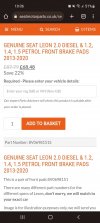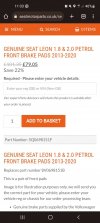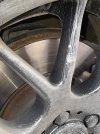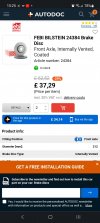The 184tdi has 312x25mm front brakes PR:1ZA & 272x10mm PR:1KS rear brakes.
The wear sensor is positioned to trigger the brake warning light at around 3mm from the pad back plate.
You really should be changing your pads by 2-3mm minimum remaining friction material so that gives you 0-1mm left of available wear so personally I would look to change within a few weeks.
You only have 1x wear sensor (on the RH pad) so you should check the LH side to see how much material is left - could be less?
The wear sensor comes with the OE pads or decent aftermarket pads.
Your new original pads had 13.5mm total friction material so you have worn through around 10.5mm - you can work out your mileage from that 10.5mm.
High quality pads use underlayer (modified friction material used for better noise damping and friction material adhesion) which is around 1.5-2.0mm thick and while still safe you should really change your pads before getting to this underlayer.
The OE pads and decent aftermarket pads have a leading edge piston cut out (on the inboard pad) - meaning they are directional so you need to observe the directional arrow - indication wheel rotation when driving forward.
Personally I would be searching for the genuine pads using either - 8V0698151B or 5Q0698151AH.
You can find them cheaper than aftermarket 'Brembo' which I would avoid, you're just paying for the name for some crap pads.
Check your discs as well - how much of a lip do they have? minimum thickness is 22mm from 25mm when new. You can measure this with a cheap digital caliper and some spacers (penny's work fine) so you are measuring the actual disc friction surface and not the rime thickness.
Fitting new pads to worn discs has a much greater chance of noise so unless the discs are in good condition I would personally change these as well.
#edit.#
worth checking you actually have worn brake pads as the warning indicator can light with just a wiring fault.
The wear sensor is positioned to trigger the brake warning light at around 3mm from the pad back plate.
You really should be changing your pads by 2-3mm minimum remaining friction material so that gives you 0-1mm left of available wear so personally I would look to change within a few weeks.
You only have 1x wear sensor (on the RH pad) so you should check the LH side to see how much material is left - could be less?
The wear sensor comes with the OE pads or decent aftermarket pads.
Your new original pads had 13.5mm total friction material so you have worn through around 10.5mm - you can work out your mileage from that 10.5mm.
High quality pads use underlayer (modified friction material used for better noise damping and friction material adhesion) which is around 1.5-2.0mm thick and while still safe you should really change your pads before getting to this underlayer.
The OE pads and decent aftermarket pads have a leading edge piston cut out (on the inboard pad) - meaning they are directional so you need to observe the directional arrow - indication wheel rotation when driving forward.
Personally I would be searching for the genuine pads using either - 8V0698151B or 5Q0698151AH.
You can find them cheaper than aftermarket 'Brembo' which I would avoid, you're just paying for the name for some crap pads.
Check your discs as well - how much of a lip do they have? minimum thickness is 22mm from 25mm when new. You can measure this with a cheap digital caliper and some spacers (penny's work fine) so you are measuring the actual disc friction surface and not the rime thickness.
Fitting new pads to worn discs has a much greater chance of noise so unless the discs are in good condition I would personally change these as well.
#edit.#
worth checking you actually have worn brake pads as the warning indicator can light with just a wiring fault.





